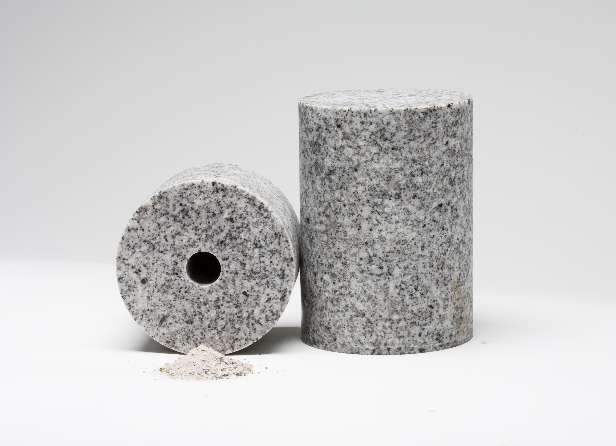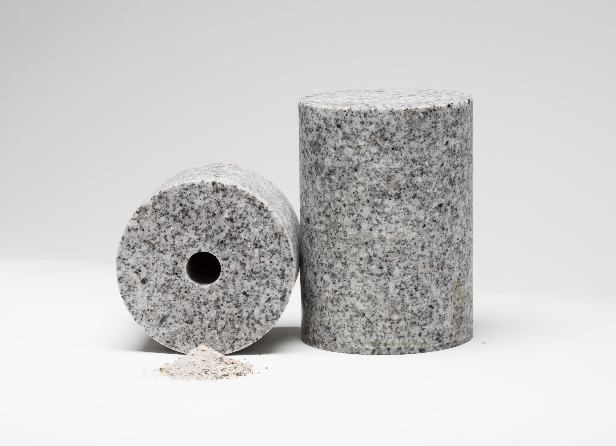
A veteran of the Manhattan Project is developing technology that could make it easier to tap geothermal energy locked deep underground.
Potter Drilling
It’s the archetypal Silicon Valley story: Unknown entrepreneur toils away on a Big Idea in an anonymous office park until discovered by one of the Valley’s legendary deep-pocketed investors.
Another boy wonder CEO hatching the next Twitter or Facebook? Not quite. Meet Bob Potter, 88. He started his hardware company when he was just 83 with technology that grew out of his work on the Manhattan Project (yes, that Manhattan Project) back in the 1940s at Los Alamos National Laboratory in New Mexico.
It’s all about bits, not bytes. Bits as in drill bits. Potter Drilling is developing a deep-drilling technology to tap geothermal heat miles below the earth’s surface — heat that could be used to generate carbon-free electricity.
Conventional geothermal power plants draw upon underground aquifers of hot water relatively close to the surface to create steam that drives electricity-generating turbines. The problem is that underground water currently tapped for geothermal is found mainly in the western United States. But the technology Potter is developing could drill much deeper, meaning geothermal energy could be generated nationwide.
According to a 2006 MIT study, so-called Enhanced Geothermal Systems could potentially supply 2,500 times the country’s current energy consumption. That grabbed Google’s attention, and last August the Internet giant’s philanthropic arm agreed to invest $4 million in Potter Drilling as part of its green energy initiative.
The tech twist: Potter drills not with hard-as-diamonds bits but with water — extremely hot water. (More on that in a bit.) The goal is to radically cut the cost of EGS to spread the technology to regions that rely too much on coal for generating electricity but are not suited for solar, wind and other renewable energy generation.
“It is fun to see some old dreams come true,” says Potter standing in the company’s Redwood City lab-slash-workshop in a light-industrial park wedged in between Interstate 101 and the railroad tracks. He has just pulled into the parking lot after making the 1,200-mile drive up from his home in New Mexico (with a side trip to Fresno to visit his 95-year-old brother).
Tall and lean and partial to bolo ties, Potter looks as much a western rancher as a rocket scientist. He is in fact one of the fathers of EGS. Starting in the 1950s, Potter and colleagues at Los Alamos began investigating the potential of fracturing pockets of super-heated rocks located deep beneath earth’s surface. Their idea: Inject water in the fractured rock and pump the hot water to the surface to create steam to drive a turbine. The water is then re-circulated back underground in a closed loop.
But Potter soon encountered a major obstacle to making geothermal as common as coal: Drilling as deep as six miles below the earth’s surface is incredibly expensive, presenting a host of obstacles to overcome. Even conventional geothermal developers spend millions of dollars to just drill test wells. But EGS rigs must penetrate miles of hard rock that slows drilling to a crawl. And a broken drill bit 30,000 feet underground can force the abandonment of a $10 million well.
“Getting into the drilling was forced on us in a way because that was thing that really prevented hot fractured rocks from being viable,” says Potter.
When government funding of geothermal research dried up with the crash of oil prices in the early 1980s, Potter moved on to other endeavors. But in the late 1990s he returned to geothermal, and with MIT chemical engineering expert Jefferson Tester patented a drilling technology called hydrothermal spallation. Potter then persuaded his son Jared to start a company in 2004 to commercialize the technology and serve as its CEO.
The younger Potter holds a Ph.D. in geology from Stanford University and had already started two Silicon Valley geological-related companies. Potter Drilling limped along for a few years, unable to interest the Valley’s venture capitalists to fund basic R&D on something that seemed so, well, industrial and old economy.
Then Google came calling on a recommendation from Tester. “If Google hadn’t come along, the company would have died,” says Jared Potter, 56.
What sealed the Google deal was a demo of Potter Drilling’s technology like the one I’m about to see. We’re standing in front of a contraption that looks like a prop from the original “Star Trek.” Salad plate-sized analog gauges line either side of the seven-foot-tall U-shaped device. Suspended in the center is a silver container about the size of small beer keg connected to various tubes and valves.
A technician loads a 4 x 6-inch cylinder of solid Sierra white granite into the bottom of the container. Above the granite is the drill apparatus. It resembles a round garden hose nozzle with slotted openings at the end. We put on safety glasses and switches are flipped, buttons pushed. As chemical reactants begin to heat up the water supply, a battered, second-hand flat-screen monitor attached to the apparatus shows the temperature rising — 200C, 400C, 600C. When it hits 800C (lead melts at 327C), the hot water is forced through nozzle. As the sound of the machinery intensifies, the jets of water begin to fracture the surface of the granite, dislodging tiny particles of the rock.
About two minutes later, the too-hot-to-handle chunk of granite is removed and now features a round, 3.5-inch-long, 1.25 inch-diameter bore hole through its middle.
By dispensing with breakable drill bits and other components that risk failing at great depths, the Potters hope to jump-start EGS by slashing both the cost and the time it takes to drill a well, which can account for more than half of a geothermal power plant’s price tag. That drilling risk has proven a deterrent to investors who don’t want to take the chance of literally pouring millions of dollars down a dry hole.
“We think we can cut the cost by 50 percent,” says Jared Potter. That has sparked interest from such leading EGS companies as Geodynamics of Australia.
But getting from the lab to the center of the earth, as it were, is another matter. Later this year, Potter Drilling will take the technology into the field at its first test site in the foothills of the Sierra Nevada, where the company plans to drill a 1,000-foot hole. The further down they go, the greater the technological challenges, such as maintaining super high water temperatures and evacuating the displaced rock particles.
“Will the technology work? Maybe,” says Mark Taylor, a geothermal analyst at market research firm New Energy Finance. “I think it’s got great promise.”
To make the technology viable will take money. Geothermal has been something of a loser in the green energy stakes, with most private and governmental funding flowing to solar and wind companies. But the Obama administration has increased funding for geothermal, and Potter Drilling has applied for a U.S. Department of Energy grant. The company will soon need to raise venture funding to commercialize its technology.
Given that Bob Potter hashed out the initial calculations for hydrothermal spallation by hand — “I never did get into computers,” he says — any risk-taking venture capitalist’s money probably will go far.



